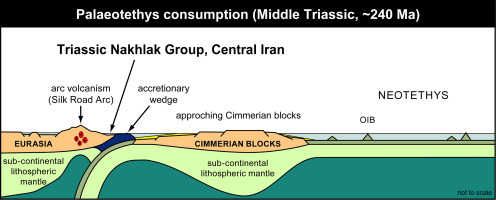当前位置:
X-MOL 学术
›
Gondwana Res.
›
论文详情
Our official English website, www.x-mol.net, welcomes your
feedback! (Note: you will need to create a separate account there.)
Permian–Triassic magmatism in response to Palaeotethys subduction and pre-Late Triassic arrival of northeast Gondwana-derived continental fragments at the southern Eurasian margin: Detrital zircon evidence from Triassic sandstones of Central Iran
Gondwana Research ( IF 7.2 ) Pub Date : 2020-07-01 , DOI: 10.1016/j.gr.2020.02.001 Guido Meinhold , Seyyedeh Halimeh Hashemi Azizi , Jasper Berndt
Gondwana Research ( IF 7.2 ) Pub Date : 2020-07-01 , DOI: 10.1016/j.gr.2020.02.001 Guido Meinhold , Seyyedeh Halimeh Hashemi Azizi , Jasper Berndt

|
Abstract The closure of Palaeotethys that led to the collision of the Cimmerian blocks with the southern Eurasian margin causing the Eo-Cimmerian orogeny during the Early Mesozoic is still controversially discussed. The Triassic Nakhlak Group in Central Iran is a key sedimentary succession for better understanding the closure of Palaeotethys and the Eo-Cimmerian orogeny in the Middle East. The Nakhlak Group is composed of the Alam (Olenekian to Middle Anisian), Baqoroq (?Upper Anisian to Middle Ladinian) and Ashin (Upper Ladinian to ?Carnian) formations, which consist mainly of volcaniclastic sandstones, mixed siliciclastic conglomerates, and marine carbonates. Here we present for the first time detrital zircon U Pb ages from the Nakhlak Group to unravel its provenance and constrain its palaeotectonic position within the Palaeotethyan realm. Most detrital zircons from the Nakhlak Group are euhedral and subhedral with Permian–Triassic ages (ca. 280–240 Ma) suggesting sediment supply from Permian–Triassic magmatic rocks of the Silk Road Arc. Minor zircon populations show pre-Permian Palaeozoic ages, with age peaks at ca. 320 Ma and 480 Ma, which are probably derived from the basement on which the magmatic arc developed. Neoproterozoic–latest Mesoproterozoic (ca. 550–1100 Ma) and Palaeoproterozoic (ca. 1800–2200 Ma) zircon grains are anhedral (rounded). The latter are prominent in the upper Baqoroq Formation (Middle Ladinian) suggesting recycling of older sedimentary rocks. Sandstone petrography points toward an additional metamorphic provenance for this formation. This short-lived provenance change can be explained by tectonic uplift in the source area that led to erosion of metamorphosed rocks with a northeast Gondwanan affinity. It clearly indicates that northeast Gondwana-derived continental fragments likely belonging to the Cimmerian blocks already arrived at the southern Eurasian margin in pre-Late Triassic time. Current palaeotectonic models of the closure of Palaeotethys and the Eo-Cimmerian orogeny in the Middle East during the Triassic may need to be revised.
中文翻译:

二叠纪-三叠纪岩浆活动对古特提斯俯冲和晚三叠纪前到达欧亚大陆边缘冈瓦纳大陆东北部大陆碎片的响应:来自伊朗中部三叠纪砂岩的碎屑锆石证据
摘要 古特提斯的闭合导致辛梅里纪块体与欧亚大陆南部边缘的碰撞导致早中生代始始辛梅里纪造山运动,目前仍存在争议。伊朗中部的三叠纪 Nakhlak 群是一个重要的沉积层序,可以更好地了解古特提斯的闭合和中东的 Eo-Cimmerian 造山运动。Nakhlak 群由 Alam(Olenekian 到 Middle Anisian)、Baqoroq(?Upper Anisian 到 Middle Ladinian)和 Ashin(上 Ladinian 到?Carnian)地层组成,主要由火山碎屑砂岩、混合硅质碎屑砾岩和海相碳酸盐岩组成。在这里,我们首次展示了来自 Nakhlak 群的碎屑锆石 U Pb 年龄,以揭示其来源并限制其在古泰提斯界内的古构造位置。来自 Nakhlak 群的大多数碎屑锆石为自形和亚自形,二叠纪-三叠纪时代(约 280-240 Ma)表明沉积物来自丝绸之路弧的二叠纪-三叠纪岩浆岩。次要锆石群显示出前二叠纪古生代年龄,年龄峰值约为 320 Ma 和 480 Ma,可能来自岩浆弧发育的基底。新元古代 - 最新的中元古代(约 550-1100 Ma)和古元古代(约 1800-2200 Ma)锆石颗粒是无面体(圆形)。后者在上部 Baqoroq 组(中拉迪阶)中很突出,表明旧沉积岩的再循环。砂岩岩相学指向该地层的另一个变质物源。这种短暂的物源变化可以用源区的构造抬升来解释,导致变质岩的侵蚀与冈瓦纳东北部的亲缘关系。这清楚地表明,可能属于 Cimmerian 地块的东北冈瓦纳大陆碎片已经在晚三叠世之前到达欧亚大陆南部边缘。三叠纪期间中东古特提斯的闭合和始基梅里纪造山运动的当前古构造模型可能需要修改。
更新日期:2020-07-01
中文翻译:

二叠纪-三叠纪岩浆活动对古特提斯俯冲和晚三叠纪前到达欧亚大陆边缘冈瓦纳大陆东北部大陆碎片的响应:来自伊朗中部三叠纪砂岩的碎屑锆石证据
摘要 古特提斯的闭合导致辛梅里纪块体与欧亚大陆南部边缘的碰撞导致早中生代始始辛梅里纪造山运动,目前仍存在争议。伊朗中部的三叠纪 Nakhlak 群是一个重要的沉积层序,可以更好地了解古特提斯的闭合和中东的 Eo-Cimmerian 造山运动。Nakhlak 群由 Alam(Olenekian 到 Middle Anisian)、Baqoroq(?Upper Anisian 到 Middle Ladinian)和 Ashin(上 Ladinian 到?Carnian)地层组成,主要由火山碎屑砂岩、混合硅质碎屑砾岩和海相碳酸盐岩组成。在这里,我们首次展示了来自 Nakhlak 群的碎屑锆石 U Pb 年龄,以揭示其来源并限制其在古泰提斯界内的古构造位置。来自 Nakhlak 群的大多数碎屑锆石为自形和亚自形,二叠纪-三叠纪时代(约 280-240 Ma)表明沉积物来自丝绸之路弧的二叠纪-三叠纪岩浆岩。次要锆石群显示出前二叠纪古生代年龄,年龄峰值约为 320 Ma 和 480 Ma,可能来自岩浆弧发育的基底。新元古代 - 最新的中元古代(约 550-1100 Ma)和古元古代(约 1800-2200 Ma)锆石颗粒是无面体(圆形)。后者在上部 Baqoroq 组(中拉迪阶)中很突出,表明旧沉积岩的再循环。砂岩岩相学指向该地层的另一个变质物源。这种短暂的物源变化可以用源区的构造抬升来解释,导致变质岩的侵蚀与冈瓦纳东北部的亲缘关系。这清楚地表明,可能属于 Cimmerian 地块的东北冈瓦纳大陆碎片已经在晚三叠世之前到达欧亚大陆南部边缘。三叠纪期间中东古特提斯的闭合和始基梅里纪造山运动的当前古构造模型可能需要修改。











































 京公网安备 11010802027423号
京公网安备 11010802027423号